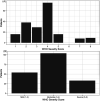This is a preprint.
SARS-CoV-2 RNAaemia predicts clinical deterioration and extrapulmonary complications from COVID-19
- PMID: 33398290
- PMCID: PMC7781329
- DOI: 10.1101/2020.12.19.20248561
SARS-CoV-2 RNAaemia predicts clinical deterioration and extrapulmonary complications from COVID-19
Update in
-
SARS-CoV-2 RNAemia Predicts Clinical Deterioration and Extrapulmonary Complications from COVID-19.Clin Infect Dis. 2022 Jan 29;74(2):218-226. doi: 10.1093/cid/ciab394. Clin Infect Dis. 2022. PMID: 33949665 Free PMC article.
Abstract
Background: The determinants of COVID-19 disease severity and extrapulmonary complications (EPCs) are poorly understood. We characterise the relationships between SARS-CoV-2 RNAaemia and disease severity, clinical deterioration, and specific EPCs.
Methods: We used quantitative (qPCR) and digital (dPCR) PCR to quantify SARS-CoV-2 RNA from nasopharyngeal swabs and plasma in 191 patients presenting to the Emergency Department (ED) with COVID-19. We recorded patient symptoms, laboratory markers, and clinical outcomes, with a focus on oxygen requirements over time. We collected longitudinal plasma samples from a subset of patients. We characterised the role of RNAaemia in predicting clinical severity and EPCs using elastic net regression.
Findings: 23·0% (44/191) of SARS-CoV-2 positive patients had viral RNA detected in plasma by dPCR, compared to 1·4% (2/147) by qPCR. Most patients with serial measurements had undetectable RNAaemia 10 days after onset of symptoms, but took 16 days to reach maximum severity, and 33 days for symptoms to resolve. Initially RNAaemic patients were more likely to manifest severe disease (OR 6·72 [95% CI, 2·45 - 19·79]), worsening of disease severity (OR 2·43 [95% CI, 1·07 - 5·38]), and EPCs (OR 2·81 [95% CI, 1·26 - 6·36]). RNA load correlated with maximum severity (r = 0·47 [95% CI, 0·20 - 0·67]).
Interpretation: dPCR is more sensitive than qPCR for the detection of SARS-CoV-2 RNAaemia, which is a robust predictor of eventual COVID-19 severity and oxygen requirements, as well as EPCs. Since many COVID-19 therapies are initiated on the basis of oxygen requirements, RNAaemia on presentation might serve to direct early initiation of appropriate therapies for the patients most likely to deteriorate.
Conflict of interest statement
Declaration of interests SY is a Scientific Advisory Board member of COMBiNATi Inc.
Figures






References
-
- WHO Coronavirus Disease (COVID-19) Dashboard. https://covid19.who.int (accessed Dec 17, 2020).
Publication types
Grants and funding
LinkOut - more resources
Full Text Sources
Miscellaneous
